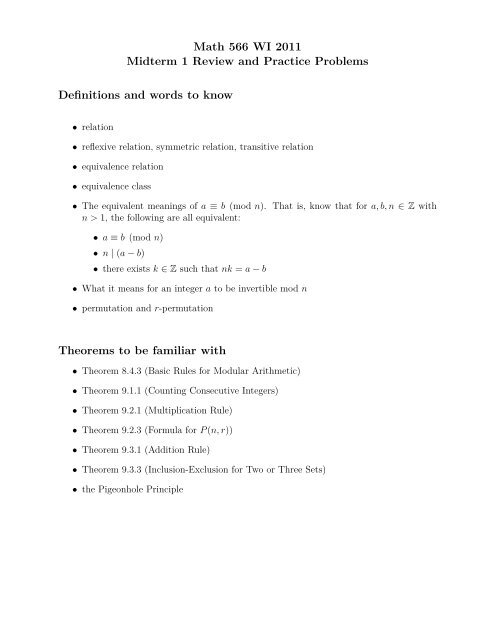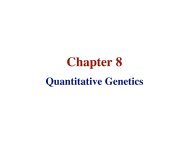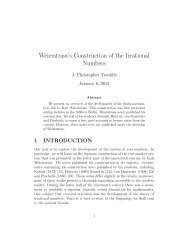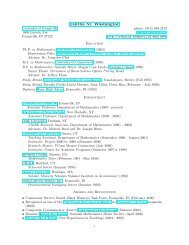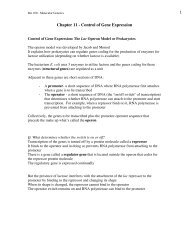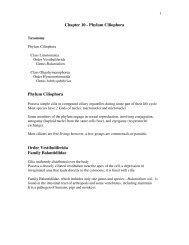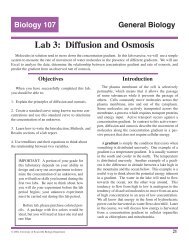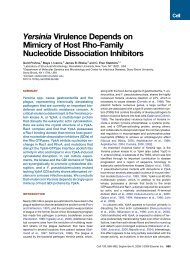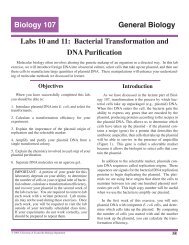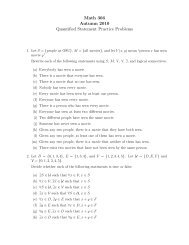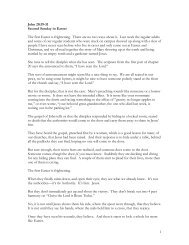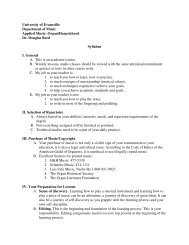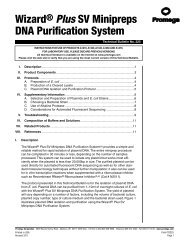Math 566 WI 2011 Midterm 1 Review and Practice Problems ...
Math 566 WI 2011 Midterm 1 Review and Practice Problems ...
Math 566 WI 2011 Midterm 1 Review and Practice Problems ...
You also want an ePaper? Increase the reach of your titles
YUMPU automatically turns print PDFs into web optimized ePapers that Google loves.
<strong>Math</strong> <strong>566</strong> <strong>WI</strong> <strong>2011</strong><strong>Midterm</strong> 1 <strong>Review</strong> <strong>and</strong> <strong>Practice</strong> <strong>Problems</strong>Definitions <strong>and</strong> words to know• relation• reflexive relation, symmetric relation, transitive relation• equivalence relation• equivalence class• The equivalent meanings of a ≡ b (mod n). That is, know that for a, b, n ∈ Z withn > 1, the following are all equivalent:• a ≡ b (mod n)• n | (a − b)• there exists k ∈ Z such that nk = a − b• What it means for an integer a to be invertible mod n• permutation <strong>and</strong> r-permutationTheorems to be familiar with• Theorem 8.4.3 (Basic Rules for Modular Arithmetic)• Theorem 9.1.1 (Counting Consecutive Integers)• Theorem 9.2.1 (Multiplication Rule)• Theorem 9.2.3 (Formula for P (n, r))• Theorem 9.3.1 (Addition Rule)• Theorem 9.3.3 (Inclusion-Exclusion for Two or Three Sets)• the Pigeonhole Principle
<strong>Practice</strong> <strong>Problems</strong>Relations1. Prove whether or not each of the following relations is reflexive, symmetric, or transitive.If any relation is an equivalence relation, determine the equivalence classes.(a) The relation D defined on Z by m D n ⇔ m | 2n(b) The relation R defined on R by x R y ⇔ xy > 0(c) The set A = {−5, −4, −3, −2, −1, 0, 1, 2, 3, 4, 5} with relation S defined byx S y ⇔ 3 | (x 2 − y 2 )Modular Arithmetic1. Let x be an odd integer. Prove that 16 | x 4 − 1.2. Let p be an odd prime such that p is the sum of two squares (that is, there existx, y ∈ Z such that p = x 2 + y 2 ). Prove that p ≡ 1 (mod 4).(It is also true that any prime congruent to 1 (mod 4) is a sum of two squares, butthat is much harder to prove).3. Take as given that 101 is invertible mod 1116. Assume that while you were doingsuccessive squaring to compute 101 331 mod 1116, you notice that(a) Prove that 101 30 ≡ 1 (mod 1116).101 2 ≡ 101 32 (mod 1116).(b) Compute 101 331 mod 1116 by using part (a).4. Given any integer a, the ordinary way to write a is as a sequence of digits a =a n a n−1 a n−2 . . . a 1 a 0 , where a i ∈ {0, 1, 2, . . . , 8, 9} for each 0 ≤ i ≤ n. By the sumof the digits of a, we mean the sum a n + a n−1 + · · · + a 1 + a 0 .(a) Prove that if the sum of the digits of a is divisible by 3, then a is divisible by 3.(b) Prove that if the sum of the digits of a is divisible by 3 <strong>and</strong> a is even, then a isdivisible by 6.Consecutive Integers1. How many integers from 1337 to 3614 inclusive are divisible by 4?2. How many integers from 1337 to 3614 inclusive are divisible by 3?3. How many integers from 1337 to 3614 inclusive are divisible by 4 <strong>and</strong> divisible by 3?
4. How many integers from 1337 to 3614 inclusive are divisible by 4 or divisible by 3?5. How many integers from 1337 to 3614 inclusive are divisible by 4 or divisible by 6?Counting <strong>Problems</strong> <strong>and</strong> Permutations1. In a certain state, all license plates are eight characters long. The first five charactersare always letters A – Z <strong>and</strong> the last two characters are digits 0 – 9.(a) How many different license plates are possible?(b) How many different plates begin with A <strong>and</strong> end with 7?(c) How many different plates end with an even number?(d) How many different plates contain the letters XY in order at least once?(e) How many different plates contain the letters XY in order at least once, containthe letters AB in order at least once, <strong>and</strong> end with an even number?2. (a) How many different ways can the letters in CASHEW be selected <strong>and</strong> written ina row (assume no letter is repeated)?(b) How many different ways can three of the letters in CASHEW be selected <strong>and</strong>written in a row?(c) How many different ways can the letters in CASHEW be selected <strong>and</strong> written ina row if W must be the first letter?(d) How many different ways can five of the letters in CASHEW be selected <strong>and</strong>written in a row if W must be the first letter <strong>and</strong> AS must be the last two letters?3. Assume that a computer password must be seven characters long <strong>and</strong> may only consistof the letters A – Z <strong>and</strong> the digits 0 – 9.(a) How many such passwords contain at least one letter?(b) How many such passwords contain at least two letters?(c) How many such passwords contain exactly one digit?(d) How many such passwords contain at least one letter <strong>and</strong> at least one digit?4. Prove that for all integers n ≥ 3,P (n + 1, 3) − P (n, 3) = 3P (n, 2).Inclusion-Exclusion1. A group of scientists are wasting time <strong>and</strong> money by studying the behaviors of dogs.The scientists are focussing on three behaviors: whether a dog preferred eating steakto all other food, whether a dog enjoyed chasing squirrels, <strong>and</strong> whether a dog oftenbarked for no apparent reason. Among a group of 150 dogs, they discover that
• 78 preferred steak• 85 enjoyed chasing squirrels• 78 often barked• 43 preferred steak <strong>and</strong> enjoyed chasing squirrels• 51 preferred steak <strong>and</strong> often barked• 49 enjoyed chasing squirrels <strong>and</strong> often barked• 37 preferred steak, enjoyed chasing squirrels, <strong>and</strong> often barked(a) How many dogs enjoyed chasing squirrels but did not often bark?(b) How many dogs often barked but did not enjoy chasing squirrels?(c) How many dogs exhibited all three of the behaviors under consideration?(d) How many dogs exhibited none of the behaviors under consideration?(e) How many of the dogs either preferred steak or enjoyed chasing squirrels, but didnot often bark?Pigeonhole Principle1. Assume that every human has between 0 <strong>and</strong> 150,000 hairs on their head. Also assumethat the city of Columbus has a population of 700,000.(a) Must there be two people in Columbus who have the same number of hairs ontheir head?(b) Must there be four people in Columbus who have the same number of hairs ontheir head?(c) Must there be six people in Columbus who have the same number of hairs ontheir head?2. How many integers from 100 to 999 must for you pick in order to be sure that at leasttwo of them have a digit in common? (For example, 256 <strong>and</strong> 530 have the digit 5 incommon, but 256 <strong>and</strong> 430 have no digits in common).


